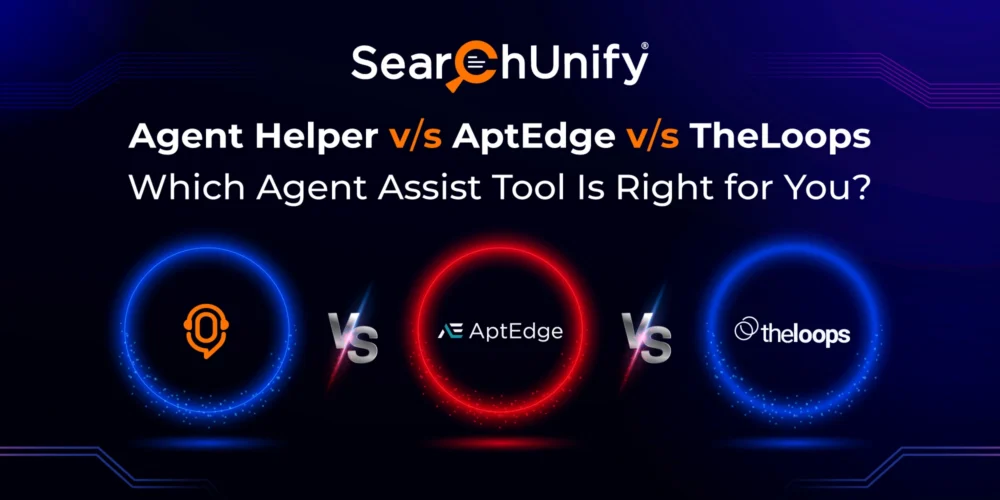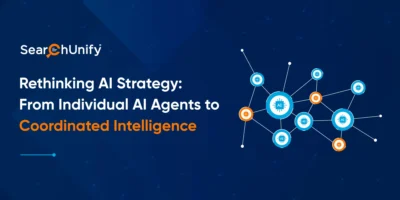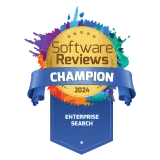
You’ve got the agents. You’ve got the data. But is your support infrastructure working with you, or against you?
For many enterprise support teams, the issue isn’t a lack of systems, it’s the lack of synergy. Agents jump between platforms. Knowledge sits in silos. And insights that should drive action remain buried in dashboards.
That’s why agent assist platforms have moved from “nice-to-have” to essential. The right one can transform scattered support into a seamless, intelligence-driven experience, for both agents and customers.
This blog offers a straight-up, side-by-side look at three such solutions: SearchUnify Agent Helper, AptEdge, and TheLoops. If you’re mapping your next-gen support stack, this guide will help you cut through the noise and choose wisely.
This guide offers a clear, no-fluff comparison to help you make the smart call—whether you’re overhauling your support stack or just fine-tuning it for scale and synergy.
| Capability | SearchUnify Agent Helper | AptEdge | TheLoops |
|---|---|---|---|
| Agent & Case Management | |||
| Automatic & Manual Case Assignment | ✓ Supports routing and assignment workflows | ✓ Supports case assignment | ✓ Supports case assignment |
| Customer Journey & Search History | ✓ Tracks customer journey and includes search history | ✗ Not available | ✗ Only journey tracking, no search history |
| Top/Related Article Suggestion | ✓ Recommends relevant knowledge base articles | ✓ Provides article suggestions | ✓ Offers article suggestions |
| Top/Related Case Suggestion | ✓ Suggests similar past cases during resolution | ✓ Provides related case suggestions | ✓ Surfaces similar past cases |
| Top SME’s/Agents Suggestion | ✓ Top SMEs suggestion/recommendation for the users to choose from | ✗ Not supported | ✗ Not supported |
| Response Assist | ✓ Assists agents with AI-generated responses | ✓ Provides reply assist | ✓ Offers response generation support |
| Sentiment Analysis (Ticket) | ✓ Detects sentiment in tickets for context | ✗ Not available | ✓ Offers sentiment detection |
| Case Backlog Summary | ✓ Summarizes pending/unresolved cases | ✗ Not available | ✓ Provides backlog visibility |
| Advanced Case Clustering | ✓ Supports grouping of cases by status or signals | ✗ Not available | ✗ Not available |
| Case Timeline | ✓ Supports case timeline | ✗ Not available | ✓ Partially through Customer Engagement Graph |
| AI Editor | ✓ | ✓ | ✓ |
| Multi-modal Support | ✓ | ✗ Not supported | ✗ Not supported |
| Proprietary RAG for Answer Generation | ✓ Yes, FRAG | ✗ Not supported | ✗ Not supported |
| Response Tone Customization | ✓ | ✗ Not supported | ✓ |
| BYOLLM Support | ✓ | ✗ Not supported | ✗ Not supported |
| Personalized Admin Dashboards | ✓ | ✗ Not supported | ✗ Not supported |
| Advanced Adoption Analytics | ✓ | ✗ Not supported | ✗ Not supported |
| User Swarming | ✓ Unlimited user swarming supported | ✗ Not supported | ✓ Unlimited user swarming supported |
| Escalation Prediction | |||
| Retrainable Escalation Prediction Model | ✓ Model can be updated with new data over time | ✗ Not available | ✓ Retrainable prediction supported |
| Predictive Intelligence (Sentiment & Attention) | ✓ Identifies cases needing attention via predictive signals | ✗ Not supported | ✓ Predictive sentiment & alerting supported |
| Prescriptive Recommendations | ✓ Suggests actions based on predicted case outcomes | ✓ Offers prescriptive suggestions | ✓ Offers prescriptive recommendations |
| Machine Learning Model Personalization | ✓ Models can be customized per use case | ✗ Not supported | ✗ Not supported |
| Escalation Reports | ✓ Provides analytics around case escalations | ✗ Not available | ✓ Escalation reports supported |
| Case Sharing | ✓ Enables cross-platform or external case sharing | ✗ Not mentioned explicitly Possibly through Workflow Automation | ✓ Case sharing available |
| Role-based Access Control | ✓ Granular access control for teams and roles | ✓ Role-based access supported | ✓ Role-based access supported |
| Customer Sentiment Score | ✓ Calculates customer sentiment from support history | ✗ Not available | ✓ Sentiment scoring is supported |
| Custom Predictive Alerts (Attention/Sentiment Scores) | ✓ Supports customization based on customer signals | ✗ Not supported | ? Not clearly specified |
| Predictive Alerts Based on Custom Fields | ✓ Triggers alerts from any configured data field | ✗ Not supported | ✗ Not supported |
| Case SLA Missing Notification | ✓ Sends alerts for approaching or breached SLAs | ✗ Not supported | ✓ SLA alerts supported |
| Collaboration Tools for Receiving Notifications | ✓ Integrates with Salesforce & Slack for agent alerts | ✓ Slack, Email, MS Teams supported | ✓ Slack, Email, MS Teams supported |
| Unlimited Alerts | ✓ No hard cap on volume of alerts | ? Unclear/undocumented | ? Unclear/undocumented |
*Note: Though the analyst has kept sanity while doing research for the comparison by accessing authentic sources like company websites, documentation, product data sheets etc., still marginal accuracies can’t be ruled out owing to the limited information available in public domain. The clients are advised to make their decision through some background research and confirmations from the vendors regarding these parameters.
3. What Sets Them Apart
While all three tools aim to enhance agent performance, each one approaches the problem through a different lens:
- SearchUnify Agent Helper is ideal for enterprises with mature or evolving knowledge management strategies. It tightly integrates with KM systems, offers real-time contextual guidance, and uses proprietary FRAG (Federated Retrieval-Augmented Generation) to deliver accurate, explainable answers. If you’re looking for unified intelligence across agents, knowledge, and analytics, this tool fits the bill.
- AptEdge focuses on agility. Its strength lies in delivering AI-powered suggestions without heavy configuration. Fast-paced support teams—especially in tech environments—will appreciate its lightweight setup and emphasis on speed over structure.
- TheLoops takes a CXOps-centric approach. It’s designed to provide live operational intelligence by surfacing customer health signals, sentiment trends, and incident risk. Teams prioritizing observability and proactive escalation management will find value here.
4. Which One Should You Pick? (Decision Snapshot)
Here’s how the three tools stack up when matched against your support team’s specific needs:
| You should consider… | If you… |
| SearchUnify Agent Helper | Want a comprehensive agent assist solution that unifies knowledge management, real-time recommendations, contextual insights, and predictive analytics—all in one. It’s ideal for enterprises seeking deeper integration, agent efficiency, and decision-making visibility. |
| AptEdge (for gap-filling needs) | Prefer quick search capabilities and lightweight deployment—but can compromise on knowledge depth, SME suggestions, and advanced analytics. Offers translation assist, which may be useful in specific multilingual environments. |
| TheLoops (for specific CXOps use cases) | Need customer impact scores or advanced CXOps observability like churn prediction or post-case resolution notes—though you may need to supplement it with a stronger KM or agent enablement solution. |
Where Do You Go From Here?
Agent assist tools have become essential to delivering fast, consistent, and intelligent support. But choosing the right one isn’t just about ticking boxes. It’s about finding a solution that fits your workflows, knowledge strategy, and support maturity.
- If you want to connect agents, knowledge, and AI in a unified experience, SearchUnify Agent Helper stands out as a well-rounded and context-aware platform.
- If you’re looking for lightweight functionality or specific CX signal monitoring, AptEdge and TheLoops may address those focused needs. However, they may require pairing with additional tools to fill broader knowledge or analytics gaps.
The best tool is the one that grows with your team and empowers agents to do their best work.













